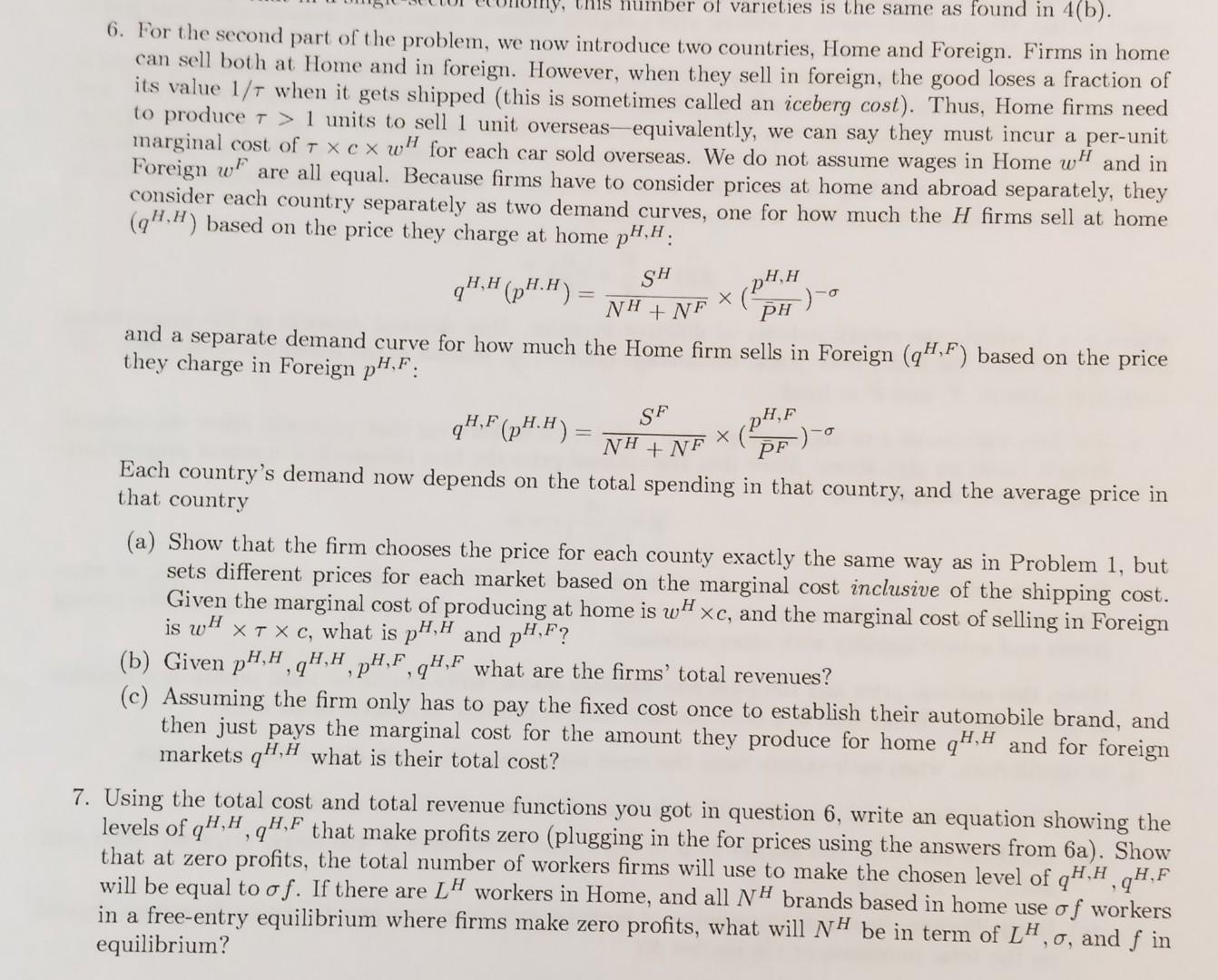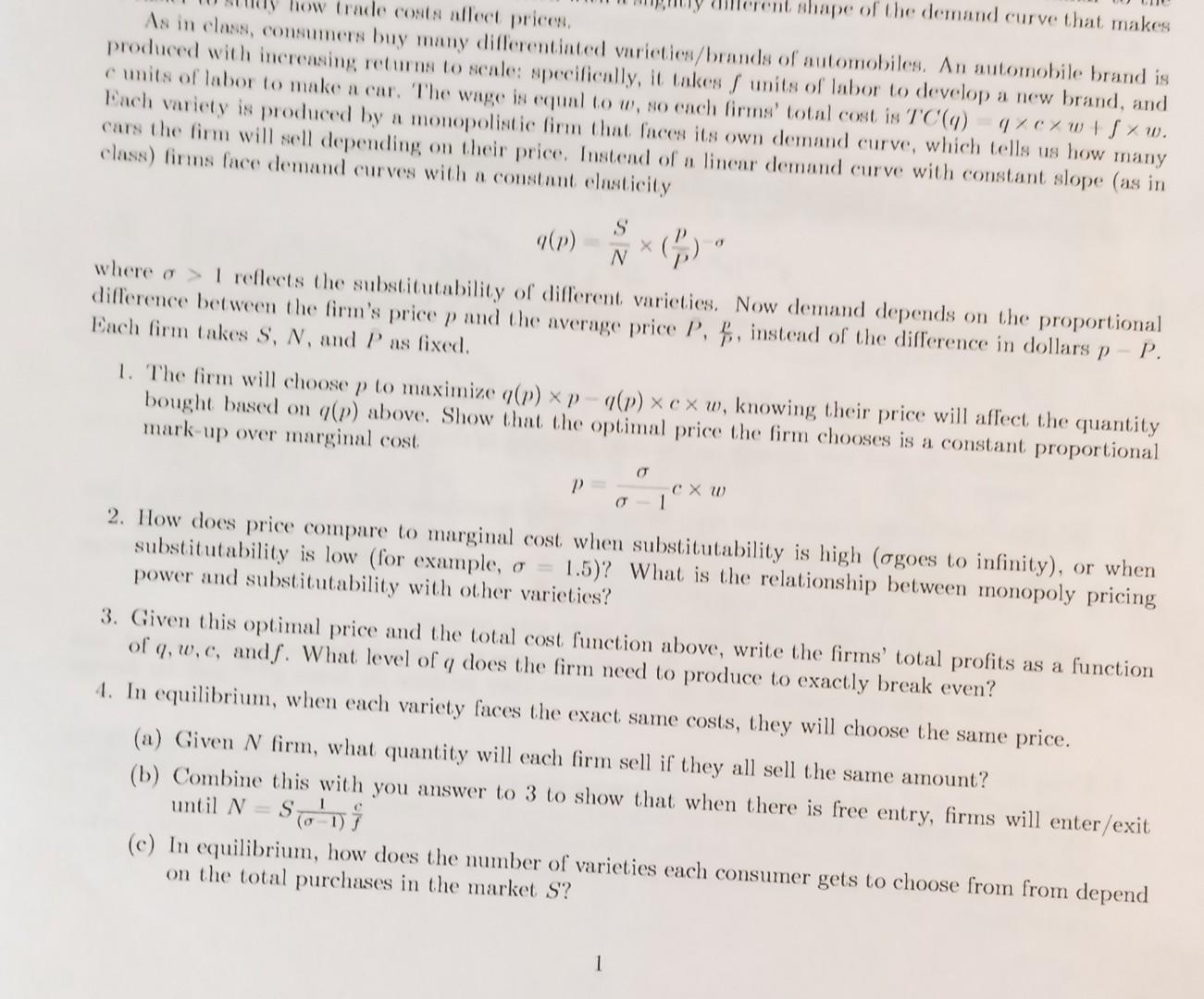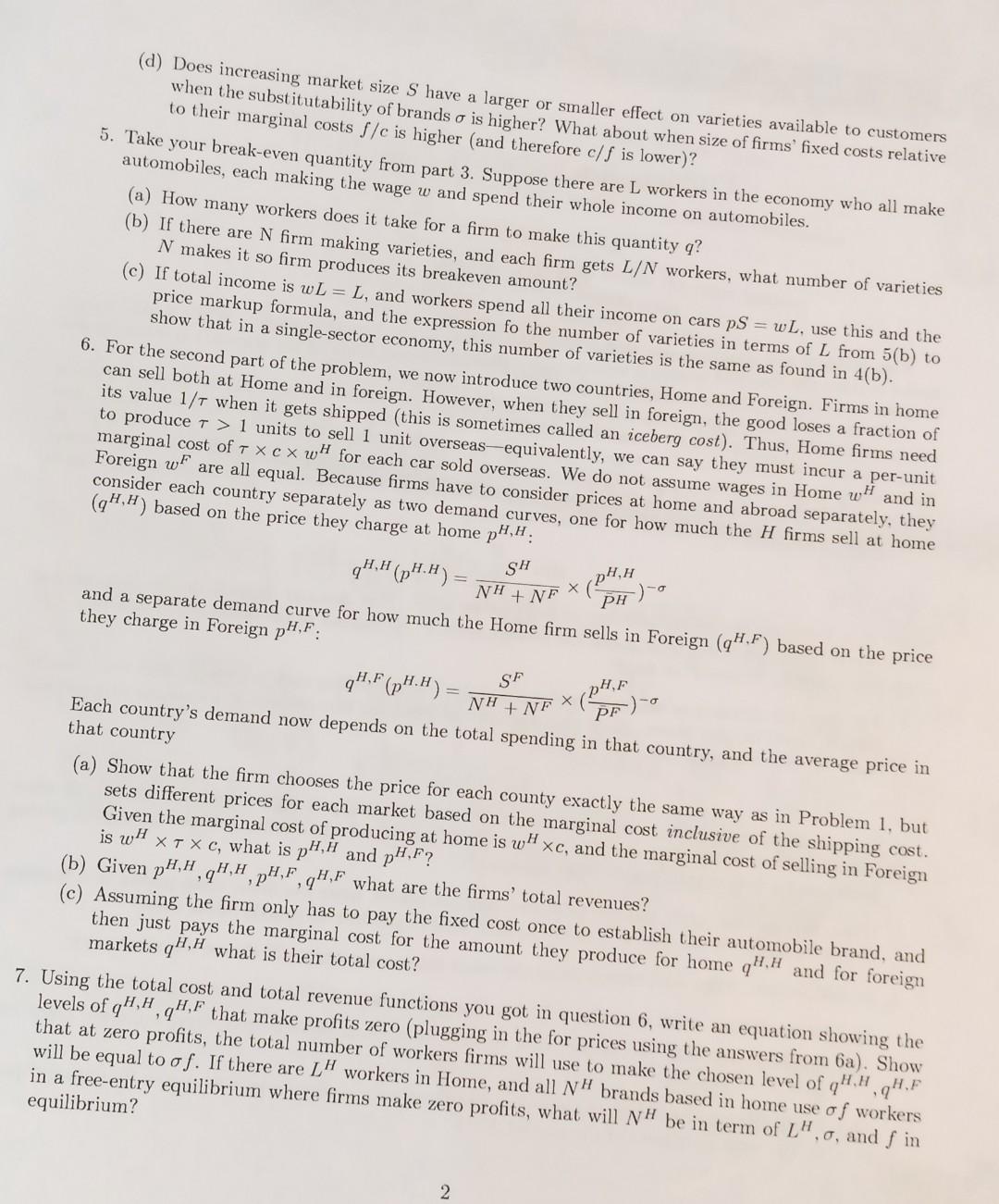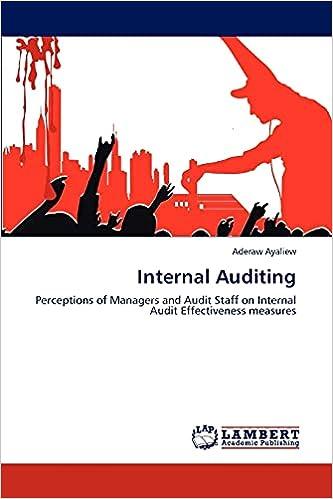Answered step by step
Verified Expert Solution
Question
1 Approved Answer
6. For the second part of the problem, we now introduce two countries, Home and Foreign. Firms in home can sell both at Home and



6. For the second part of the problem, we now introduce two countries, Home and Foreign. Firms in home can sell both at Home and in foreign. However, when they sell in foreign, the good loses a fraction of its value 1/ when it gets shipped (this is sometimes called an iceberg cost). Thus, Home firms need to produce >1 units to sell 1 unit overseas-equivalently, we can say they must incur a per-unit marginal cost of cwH for each car sold overseas. We do not assume wages in Home wH and in Foreign wF are all equal. Because firms have to consider prices at home and abroad separately, they consider each country separately as two demand curves, one for how much the H firms sell at home (qH,H) based on the price they charge at home pH,H : qH,H(pH.H)=NH+NFSH(PHpH,H) and a separate demand curve for how much the Home firm sells in Foreign (qH,F) based on the price they charge in Foreign pH,F : qH,F(pH.H)=NH+NFSF(PFpH,F) Each country's demand now depends on the total spending in that country, and the average price in that country (a) Show that the firm chooses the price for each county exactly the same way as in Problem 1, but sets different prices for each market based on the marginal cost inclusive of the shipping cost. Given the marginal cost of producing at home is wHc, and the marginal cost of selling in Foreign is wHc, what is pH,H and pH,F ? (b) Given pH,H,qH,H,pH,F,qH,F what are the firms' total revenues? (c) Assuming the firm only has to pay the fixed cost once to establish their automobile brand, and then just pays the marginal cost for the amount they produce for home qH,H and for foreign markets qH,H what is their total cost? 7. Using the total cost and total revenue functions you got in question 6, write an equation showing the levels of qH,H,qH,F that make profits zero (plugging in the for prices using the answers from 6 a). Show that at zero profits, the total number of workers firms will use to make the chosen level of qH,H,qH,F will be equal to f. If there are LH workers in Home, and all NH brands based in home use f workers in a free-entry equilibrium where firms make zero profits, what will NH be in term of LH,, and f in equilibrium? As in class, consumers buy many differentiated varieties/brands of automobiles. An automobile brand is produced with increasing returns to seale: specificully, it takes f units of labor to develop a new brand, and c units of labor to make a car. 'The wage is equal to w, so each firms' total cost is TC(q)qcw+fw. Fach variety is produced by a monopolistic firm that. faces its own demand curve, which tells us how many cars the firm will sell depending on their price. Instead of a linear demand curve with constant slope (as in class) firms face demand curves with a constant elasticity q(p)NS(pp) where >1 reflects the substitutability of diflerent, varieties. Now demand depends on the proportional difference between the firm's price p and the average price P,pp, instead of the difference in dollars pP. Each firm takes S,N, and P as fixed. 1. The firm will choose p to maximize q(p)pq(p)cw, knowing their price will affect the quantity bought based on q(p) above. Show that the optimal price the firm chooses is a constant proportional mark-up over marginal cost. p=1cw 2. How does price compare to marginal cost when substitutability is high ( goes to infinity), or when substitutability is low (for example, =1.5 )? What is the relationship between monopoly pricing power and substitutability with other varieties? 3. Given this optimal price and the total cost function above, write the firms' total profits as a function of q,w,c, and f. What level of q does the firm need to produce to exactly break even? 4. In equilibrium, when each variety faces the exact same costs, they will choose the same price. (a) Given N firm, what quantity will each firm sell if they all sell the same amount? (b) Combine this with you answer to 3 to show that when there is free entry, firms will enter/exit until N=S(1)fc1 (c) In equilibrium, how does the number of varieties each consumer gets to choose from from depend on the total purchases in the market S ? (d) Does increasing market size S have a larger or smaller effect on varieties available to customers when the substitutability of brands is higher? What about when size of firms' fixed costs relative to their marginal costs f/c is higher (and therefore c/f is lower)? 5. Take your break-even quantity from part 3. Suppose there are L workers in the economy who all make automobiles, each making the wage w and spend their whole income on automobiles. (a) How many workers does it take for a firm to make this quantity q ? (b) If there are N firm making varieties, and each firm gets L/N workers, what number of varieties N makes it so firm produces its breakeven amount? (c) If total income is wL=L, and workers spend all their income on cars pS=wL, use this and the price markup formula, and the expression fo the number of varieties in terms of L from 5 (b) to show that in a single-sector economy, this number of varieties is the same as found in 4 (b). 6. For the second part of the problem, we now introduce two countries, Home and Foreign. Firms in home can sell both at Home and in foreign. However, when they sell in foreign, the good loses a fraction of its value 1/ when it gets shipped (this is sometimes called an iceberg cost). Thus, Home firms need to produce >1 units to sell 1 unit overseas-equivalently, we can say they must incur a per-unit marginal cost of cwH for each car sold overseas. We do not assume wages in Home wH and in Foreign wF are all equal. Because firms have to consider prices at home and abroad separately, they consider each country separately as two demand curves, one for how much the H firms sell at home (qH,H) based on the price they charge at home pH,H : qH,H(pH.H)=NH+NFSH(PHpH,H) and a separate demand curve for how much the Home firm sells in Foreign (qH,F) based on the price they charge in Foreign pH,F : qH,F(pH.H)=NH+NFSF(PFpH,F) Each country's demand now depends on the total spending in that country, and the average price in that country (a) Show that the firm chooses the price for each county exactly the same way as in Problem 1, but sets different prices for each market based on the marginal cost inclusive of the shipping cost. Given the marginal cost of producing at home is wHc, and the marginal cost of selling in Foreign is wHc, what is pH,H and pH,F ? (b) Given pH,H,qH,H,pH,F,qH,F what are the firms' total revenues? (c) Assuming the firm only has to pay the fixed cost once to establish their automobile brand, and then just pays the marginal cost for the amount they produce for home qH,H and for foreign markets qH,H what is their total cost? 7. Using the total cost and total revenue functions you got in question 6 , write an equation showing the levels of qH,H,qH,F that make profits zero (plugging in the for prices using the answers from 6 ). Show that at zero profits, the total number of workers firms will use to make the chosen level of qH,H,qH,F will be equal to f. If there are LH workers in Home, and all NH brands based in home use f workers in a free-entry equilibrium where firms make zero profits, what will NH be in term of LH,, and f in equilibrium? 6. For the second part of the problem, we now introduce two countries, Home and Foreign. Firms in home can sell both at Home and in foreign. However, when they sell in foreign, the good loses a fraction of its value 1/ when it gets shipped (this is sometimes called an iceberg cost). Thus, Home firms need to produce >1 units to sell 1 unit overseas-equivalently, we can say they must incur a per-unit marginal cost of cwH for each car sold overseas. We do not assume wages in Home wH and in Foreign wF are all equal. Because firms have to consider prices at home and abroad separately, they consider each country separately as two demand curves, one for how much the H firms sell at home (qH,H) based on the price they charge at home pH,H : qH,H(pH.H)=NH+NFSH(PHpH,H) and a separate demand curve for how much the Home firm sells in Foreign (qH,F) based on the price they charge in Foreign pH,F : qH,F(pH.H)=NH+NFSF(PFpH,F) Each country's demand now depends on the total spending in that country, and the average price in that country (a) Show that the firm chooses the price for each county exactly the same way as in Problem 1, but sets different prices for each market based on the marginal cost inclusive of the shipping cost. Given the marginal cost of producing at home is wHc, and the marginal cost of selling in Foreign is wHc, what is pH,H and pH,F ? (b) Given pH,H,qH,H,pH,F,qH,F what are the firms' total revenues? (c) Assuming the firm only has to pay the fixed cost once to establish their automobile brand, and then just pays the marginal cost for the amount they produce for home qH,H and for foreign markets qH,H what is their total cost? 7. Using the total cost and total revenue functions you got in question 6, write an equation showing the levels of qH,H,qH,F that make profits zero (plugging in the for prices using the answers from 6 a). Show that at zero profits, the total number of workers firms will use to make the chosen level of qH,H,qH,F will be equal to f. If there are LH workers in Home, and all NH brands based in home use f workers in a free-entry equilibrium where firms make zero profits, what will NH be in term of LH,, and f in equilibrium? As in class, consumers buy many differentiated varieties/brands of automobiles. An automobile brand is produced with increasing returns to seale: specificully, it takes f units of labor to develop a new brand, and c units of labor to make a car. 'The wage is equal to w, so each firms' total cost is TC(q)qcw+fw. Fach variety is produced by a monopolistic firm that. faces its own demand curve, which tells us how many cars the firm will sell depending on their price. Instead of a linear demand curve with constant slope (as in class) firms face demand curves with a constant elasticity q(p)NS(pp) where >1 reflects the substitutability of diflerent, varieties. Now demand depends on the proportional difference between the firm's price p and the average price P,pp, instead of the difference in dollars pP. Each firm takes S,N, and P as fixed. 1. The firm will choose p to maximize q(p)pq(p)cw, knowing their price will affect the quantity bought based on q(p) above. Show that the optimal price the firm chooses is a constant proportional mark-up over marginal cost. p=1cw 2. How does price compare to marginal cost when substitutability is high ( goes to infinity), or when substitutability is low (for example, =1.5 )? What is the relationship between monopoly pricing power and substitutability with other varieties? 3. Given this optimal price and the total cost function above, write the firms' total profits as a function of q,w,c, and f. What level of q does the firm need to produce to exactly break even? 4. In equilibrium, when each variety faces the exact same costs, they will choose the same price. (a) Given N firm, what quantity will each firm sell if they all sell the same amount? (b) Combine this with you answer to 3 to show that when there is free entry, firms will enter/exit until N=S(1)fc1 (c) In equilibrium, how does the number of varieties each consumer gets to choose from from depend on the total purchases in the market S ? (d) Does increasing market size S have a larger or smaller effect on varieties available to customers when the substitutability of brands is higher? What about when size of firms' fixed costs relative to their marginal costs f/c is higher (and therefore c/f is lower)? 5. Take your break-even quantity from part 3. Suppose there are L workers in the economy who all make automobiles, each making the wage w and spend their whole income on automobiles. (a) How many workers does it take for a firm to make this quantity q ? (b) If there are N firm making varieties, and each firm gets L/N workers, what number of varieties N makes it so firm produces its breakeven amount? (c) If total income is wL=L, and workers spend all their income on cars pS=wL, use this and the price markup formula, and the expression fo the number of varieties in terms of L from 5 (b) to show that in a single-sector economy, this number of varieties is the same as found in 4 (b). 6. For the second part of the problem, we now introduce two countries, Home and Foreign. Firms in home can sell both at Home and in foreign. However, when they sell in foreign, the good loses a fraction of its value 1/ when it gets shipped (this is sometimes called an iceberg cost). Thus, Home firms need to produce >1 units to sell 1 unit overseas-equivalently, we can say they must incur a per-unit marginal cost of cwH for each car sold overseas. We do not assume wages in Home wH and in Foreign wF are all equal. Because firms have to consider prices at home and abroad separately, they consider each country separately as two demand curves, one for how much the H firms sell at home (qH,H) based on the price they charge at home pH,H : qH,H(pH.H)=NH+NFSH(PHpH,H) and a separate demand curve for how much the Home firm sells in Foreign (qH,F) based on the price they charge in Foreign pH,F : qH,F(pH.H)=NH+NFSF(PFpH,F) Each country's demand now depends on the total spending in that country, and the average price in that country (a) Show that the firm chooses the price for each county exactly the same way as in Problem 1, but sets different prices for each market based on the marginal cost inclusive of the shipping cost. Given the marginal cost of producing at home is wHc, and the marginal cost of selling in Foreign is wHc, what is pH,H and pH,F ? (b) Given pH,H,qH,H,pH,F,qH,F what are the firms' total revenues? (c) Assuming the firm only has to pay the fixed cost once to establish their automobile brand, and then just pays the marginal cost for the amount they produce for home qH,H and for foreign markets qH,H what is their total cost? 7. Using the total cost and total revenue functions you got in question 6 , write an equation showing the levels of qH,H,qH,F that make profits zero (plugging in the for prices using the answers from 6 ). Show that at zero profits, the total number of workers firms will use to make the chosen level of qH,H,qH,F will be equal to f. If there are LH workers in Home, and all NH brands based in home use f workers in a free-entry equilibrium where firms make zero profits, what will NH be in term of LH,, and f in equilibrium
Step by Step Solution
There are 3 Steps involved in it
Step: 1

Get Instant Access to Expert-Tailored Solutions
See step-by-step solutions with expert insights and AI powered tools for academic success
Step: 2

Step: 3

Ace Your Homework with AI
Get the answers you need in no time with our AI-driven, step-by-step assistance
Get Started


